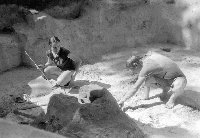VIKINGS ON THE DESNA: MASTERS OR MERCENARIES?

Recently, the site was visited by another team of archaeologists, an international expedition including scholars from Kyiv, Chernihiv, Briansk, and Trondheim (Norway). Its mission was to determine the Shestovytsia horodyshche's place and role in the archaeological structure of Europe. Those supporting the Norman theory regard it as the largest Scandinavian colony on the Desna River. This was another reason to approach the problem from a scientific, rather than political point of view. The archaeologists concentrated on the horodyshche which, according to Volodymyr Kovalenko, Chairman of the Archaeology and Ethnology Department, Chernihiv Pedagogical Institute, are historically perfectly synchronous burial sites, dating from the second ninth century, in place of an earlier Slavic settlement, which had been razed to the ground.
"This was just one episode in the 'peaceful' association of Eastern Slavs in the polity known as Kyiv Rus', a process actually accomplished by fire and sword using mercenaries hired by Kyiv princes," says Mr. Kovalenko. "No one wanted to unite just to make it easier for the princes to collect taxes, so the princes hired mercenaries to keep people under control."
The site of the military camp was chosen well. This way they could keep an eye on whoever sailed up and down the Desna, to Kyiv and Chernihiv which was an hour's ride away. The mercenaries must have been assigned to secure the Grand Prince's control over the city and, to an extent, resisted the local landed gentry.
The archaeologists studied not only the horodyshche, but also the posad (trading quarter, suburb) which was even larger. In 1983, Mr. Kovalenko unearthed about a hundred ancient production facilities. This time the team discovered a residence from the late tenth or early eleventh century.
"Today we know enough to reasonably assume that a considerable part of the posad was not permanently inhabited but used for production. This, in turn raises the question of its social status. The answer is the only obvious one: not a trace of the Viking colony," continues Volodymyr Kovalenko, adding that he has his doubts about the methods used by demographers when reconstructing the populace of Old Rus' at its peak. Using their approach, the Shestovytsia horodyshche would have had about 12,000 residents.
It will be some time before the archaeologists are able to answer questions
about the delimitation of production and dwelling premises, the average
size of the homes, and the number of residents. The expedition is planned
to last three years.
Newspaper output №:
№35, (1998)Section
Culture





